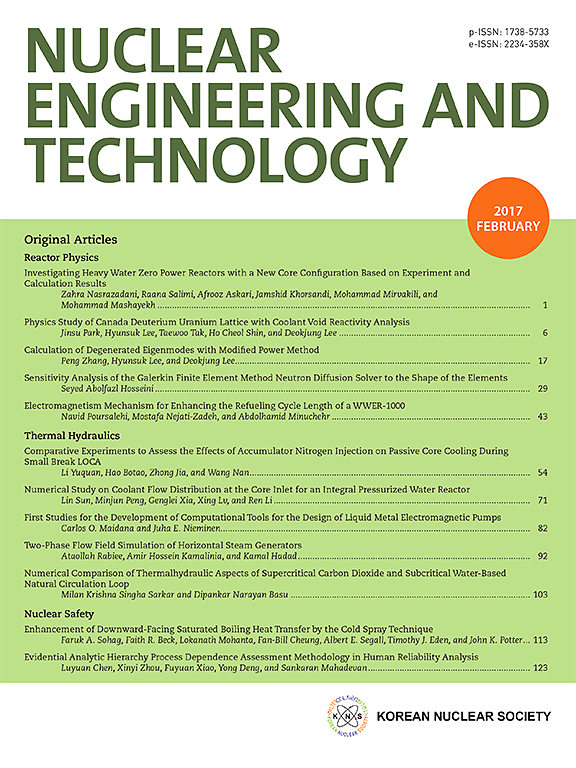Dynamic behavior of duplex stainless steel with improved chloride-induced stress corrosion cracking resistance in drop scenarios for dry storage containers
IF 2.6
3区 工程技术
Q1 NUCLEAR SCIENCE & TECHNOLOGY
引用次数: 0
Abstract
This study investigated the safety and structural integrity enhancements in dry storage containers (DSCs) achieved using a novel duplex stainless steel with a composition of Fe-19Cr-4Ni-2.5Mo-4.5Mn, referred to as advanced duplex stainless steel for a canister of dry storage (ADCS). This material was developed to improve resistance to chloride-induced stress corrosion cracking. The safety and structural integrity of DSCs utilizing ADCS and conventional austenitic stainless steel (ASS) were comparatively evaluated using finite element analysis based on detailed DSC models for vertical, oblique, and horizontal drops under accident scenarios, in accordance with International Atomic Energy Agency and U.S. Nuclear Regulatory Commission regulations. The results confirmed that ADCS significantly improved impact resistance and reduced plastic strain under impact conditions. Consequently, DSCs incorporating ADCS offer higher safety and reliability during both transportation and storage than those using conventional ASS. Furthermore, by leveraging these advantages of ADCS, DSCs can be made lighter while maintaining safety and structural integrity. Additionally, strain-based evaluations, consistent with ASME BPVC Sec. III Div. 3, demonstrated that higher margins could be achieved using ADCS where plastic deformation occurred. This highlights that ADCS is a promising material for ensuring greater structural integrity and safety in DSCs.
求助全文
约1分钟内获得全文
求助全文
来源期刊

Nuclear Engineering and Technology
工程技术-核科学技术
CiteScore
4.80
自引率
7.40%
发文量
431
审稿时长
3.5 months
期刊介绍:
Nuclear Engineering and Technology (NET), an international journal of the Korean Nuclear Society (KNS), publishes peer-reviewed papers on original research, ideas and developments in all areas of the field of nuclear science and technology. NET bimonthly publishes original articles, reviews, and technical notes. The journal is listed in the Science Citation Index Expanded (SCIE) of Thomson Reuters.
NET covers all fields for peaceful utilization of nuclear energy and radiation as follows:
1) Reactor Physics
2) Thermal Hydraulics
3) Nuclear Safety
4) Nuclear I&C
5) Nuclear Physics, Fusion, and Laser Technology
6) Nuclear Fuel Cycle and Radioactive Waste Management
7) Nuclear Fuel and Reactor Materials
8) Radiation Application
9) Radiation Protection
10) Nuclear Structural Analysis and Plant Management & Maintenance
11) Nuclear Policy, Economics, and Human Resource Development
 求助内容:
求助内容: 应助结果提醒方式:
应助结果提醒方式:


